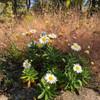
Nipponanthemum nipponicum (Chrysanthemum) - NIPPON DAISY
Very late bloomer for sunny garden and somewhat drained soils. Pest and trouble free.
The white, daisy-like flowers with yellow-green centers are 2-3" in diameter and bloom from late summer until frost. The thick, toothed, succulent dark green foliage dies back completely over the winter.
Formerly included in the Chrysanthemum genus. Other common names include the Montauk Daisy.
Excellent cut flower. Clumps may be divided every 2-3 years to propagate or support the vitality of the plants.
Blooming Time: August - October
Size: 1.5 - 3' tall and wide, the base of the stems get woody. Often the evergreen leaves stay only at the basal rosette or on the tips of stems, so it is useful to cut it back to the base (from time to time - in the spring)
USDA Zones: 5 to 9
Culture: full sun (tolerates light shade in hotter areas); average, well-drained soils
Moisture Needs: dry, average. salt and drought tolerant; does not tolerate waterlogged soil.
Origin: Nipponanthemum nipponicum is native to coastal regions of Japan, but has been cultivated in other regions and is now naturalized along the northern East Coast of the U.S. in the U.S. it grows naturally in CT, NJ, and NY in disturbed habitats, meadows, fields, and along the shores of bodies of water (USDA distribution map).
Deer/Rabbit Resistant: yes / yes
Attracts Butterflies or Pollinators: yes / yes, small butterflies and beetles, but it is far from being a pollinator magnet
Attracts Hummingbirds: no
Pot Size: square 3.5" x 4" deep pot
Plant Combinations: Goes well with any perennial or grass that thrives in somewhat drier or drained soil, both native or non-native plants. The structure of this plant is rough, so it looks well with fine structures (grasses, narrow or small leaves, or with lower or groundcovering perennials).
Combine with natives like narrow-leaved Amsonias, Antennaria, Asclepias (A. tuberosa, A. verticllata etc), Aster (A. ericoides, A. oblongifolius, A. laevis, A. oolentangiensis), Amorpha canescens, Anaphallis margaritacea, Callirhoe, Coreopsis verticillata, Clinopodium arkansanum, Cunila origanoides, Dalea, narrow-leaved Echinacea, Liatris microcephalla (or other), Oenothera, Verbena stricta and grasses like Andropogon, Boutelloua, Eragrostis, Koeleria, Panicum, Schizachyrium or Sporobolus.
Or non-native perennials Artemisia, Calamintha nepeta, Geranium sanquineum cultivars, Lavandula, Nepeta x faasenii cultivars, Perovskia, Salvia nemorosa (S. x sylvestris) or other drought tolerant Salvia, Veronica spicata.
Most of the lower leaves are lost upon flowering and preparing for dormancy - plant in the middle or back of flower beds and borders, mass plantings or small groups, rock gardens and along walls, on slopes/banks, and in coastal areas.
Picture Copyright: US Perennials nursery

Nipponanthemum nipponicum (Chrysanthemum) - NIPPON DAISY
Very late bloomer for sunny garden and somewhat drained soils. Pest and trouble free.
The white, daisy-like flowers with yellow-green centers are 2-3" in diameter and bloom from late summer until frost. The thick, toothed, succulent dark green foliage dies back completely over the winter.
Formerly included in the Chrysanthemum genus. Other common names include the Montauk Daisy.
Excellent cut flower. Clumps may be divided every 2-3 years to propagate or support the vitality of the plants.
Blooming Time: August - October
Size: 1.5 - 3' tall and wide, the base of the stems get woody. Often the evergreen leaves stay only at the basal rosette or on the tips of stems, so it is useful to cut it back to the base (from time to time - in the spring)
USDA Zones: 5 to 9
Culture: full sun (tolerates light shade in hotter areas); average, well-drained soils
Moisture Needs: dry, average. salt and drought tolerant; does not tolerate waterlogged soil.
Origin: Nipponanthemum nipponicum is native to coastal regions of Japan, but has been cultivated in other regions and is now naturalized along the northern East Coast of the U.S. in the U.S. it grows naturally in CT, NJ, and NY in disturbed habitats, meadows, fields, and along the shores of bodies of water (USDA distribution map).
Deer/Rabbit Resistant: yes / yes
Attracts Butterflies or Pollinators: yes / yes, small butterflies and beetles, but it is far from being a pollinator magnet
Attracts Hummingbirds: no
Pot Size: square 3.5" x 4" deep pot
Plant Combinations: Goes well with any perennial or grass that thrives in somewhat drier or drained soil, both native or non-native plants. The structure of this plant is rough, so it looks well with fine structures (grasses, narrow or small leaves, or with lower or groundcovering perennials).
Combine with natives like narrow-leaved Amsonias, Antennaria, Asclepias (A. tuberosa, A. verticllata etc), Aster (A. ericoides, A. oblongifolius, A. laevis, A. oolentangiensis), Amorpha canescens, Anaphallis margaritacea, Callirhoe, Coreopsis verticillata, Clinopodium arkansanum, Cunila origanoides, Dalea, narrow-leaved Echinacea, Liatris microcephalla (or other), Oenothera, Verbena stricta and grasses like Andropogon, Boutelloua, Eragrostis, Koeleria, Panicum, Schizachyrium or Sporobolus.
Or non-native perennials Artemisia, Calamintha nepeta, Geranium sanquineum cultivars, Lavandula, Nepeta x faasenii cultivars, Perovskia, Salvia nemorosa (S. x sylvestris) or other drought tolerant Salvia, Veronica spicata.
Most of the lower leaves are lost upon flowering and preparing for dormancy - plant in the middle or back of flower beds and borders, mass plantings or small groups, rock gardens and along walls, on slopes/banks, and in coastal areas.
Picture Copyright: US Perennials nursery
Customer Reviews
-
Great plant, great company
Plant arrived healthy and well packaged and is doing great in the ground. US Perennials is a quality, reliable company with a great selection, healthy plants, and quick shipping. And they send you a free pen with your order! Would recommend.





